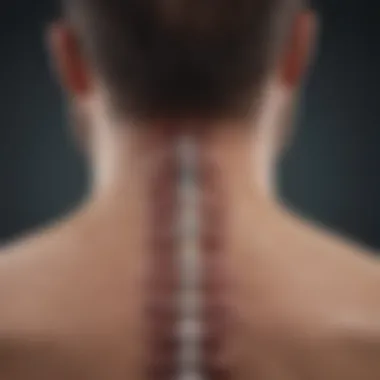Evaluating the Worth of Herniated Disc Surgery


Intro
Herniated disc surgery seems to be a significant decision for many individuals struggling with long-term back pain. As this condition can be debilitating, surgery may appear to be an attractive option for relief. However, the true worth of such an invasive procedure warrants careful evaluation. This discussion aims to consider various elements of this surgery and its implications. Both benefits and risks must be factored in for a well-rounded understanding. Furthermore, exploring alternative treatments and recovery expectations adds another layer to the conversation.
Research Overview
Summary of Key Findings
Numerous studies have investigated the effectiveness of herniated disc surgery. Results show a mixed efficacy where patient outcomes can be highly variable. While some patients experience significant pain relief and improved mobility, others report minimal or no change after surgery. A substantial number of factors can influence these outcomes, including the type of surgery performed, the patient's overall health, and adherence to rehabilitation protocols.
Methodologies Employed
Research on this topic often employs a combination of prospective and retrospective studies. In these studies, researchers frequently use clinical assessments and standardized questionnaires to obtain objective data regarding patients' pain levels and functional capabilities post-surgery. Analysis methods vary, yet meta-analysis often plays a pivotal role in synthesizing findings across different studies to reach more comprehensive conclusions.
In-Depth Analysis
Detailed Examination of Results
The outcomes from herniated disc surgeries tend to indicate that the benefits can be substantial for some but not universal. Many patients report a decrease in sciatic pain post-surgery, which correlates with significant improvements in quality of life. However, these results do not apply universally. Some individuals continue to experience pain or develop new complications. Evaluating criteria such as surgical technique and patient selection is vital in comprehending the inconsistency.
Comparison with Previous Studies
In examining various studies over the years, it's clear that surgical techniques have advanced. Earlier procedures often provided less favorable outcomes compared to modern approaches. A pivotal study from 2015 highlighted that minimally invasive techniques often yield better recovery times and less postoperative pain than traditional open surgery methods. Nonetheless, rigorous peer-reviewed comparisons are necessary to further solidify these observations.
"Understanding both surgical and non-surgical intervention outcomes is imperative in guiding patients towards the best treatment choice for their herniated disc."
Finally, the evaluation of herniated disc surgery demands a nuanced approach. Considerations extend beyond mere surgical benefits to include potential complications and long-term repercussions.
In summary, while herniated disc surgery can offer relief for some, a thorough evaluation of individual circumstances and preferences is key to ensuring appropriate treatment decisions.
Prelude to Herniated Discs
Herniated discs are a significant source of pain and discomfort for many individuals. In this section, we explore what a herniated disc is and why understanding it is crucial for anyone considering surgery. Grasping the fundamentals of herniated discs can help patients recognize the severity of their condition, enabling informed decision-making regarding possible treatments, including surgical options.
Understanding Herniated Discs
A herniated disc occurs when the soft inner material of an intervertebral disc protrudes through the outer layer. This can happen due to age-related degeneration or injury. The displacement often compresses nearby nerves, leading to pain, numbness, or weakness. The severity of these symptoms varies significantly among individuals. Some may experience mild discomfort, while others may face debilitating pain that severely impacts their quality of life.
Understanding herniated discs is crucial because it shines light on the anatomy involved. The spine consists of vertebrae, and between each vertebra sits a disc that acts as a cushion. When these discs become damaged, it doesn’t only affect the disc itself but can also lead to complications in the surrounding tissues and nerves. Thus, it becomes imperative for individuals suffering from such conditions to have a good grasp of how their body functions, as this knowledge can empower them during consultations with healthcare professionals.
Symptoms and Diagnosis
Recognizing the symptoms of a herniated disc is critical for proper diagnosis and treatment. Common symptoms include:
- Radiating Pain: Pain may radiate down the legs or arms, depending on where the herniation occurs.
- Numbness or Tingling: Patients often report feelings of numbness or tingling in various parts of the body related to nerve involvement.
- Muscle Weakness: Weakness in specific muscle groups can occur due to nerve compression.
Diagnosis usually involves a detailed medical history and physical examination. Healthcare providers often recommend imaging tests such as MRI scans to confirm the presence and severity of a herniated disc. Accurate diagnosis is a pivotal first step in determining appropriate treatment avenues, whether that be through non-surgical methods or surgical intervention.
"Understanding the symptoms and diagnosis of a herniated disc can lead individuals to a clearer path in addressing their pain and exploring treatment options."
The Surgical Landscape
The surgical landscape surrounding herniated disc treatment is a critical area of focus for both patients and healthcare professionals. This section will discuss how understanding the surgical options available can aid in making informed decisions about care. Surgery may become necessary when conservative treatments have not led to sufficient relief. Evaluating the benefits, risks, and effectiveness of various surgical approaches is essential to ascertain their value. An in-depth analysis of surgical methods helps define the role they play in alleviating pain and enhancing functional outcomes in patients.
When Surgery Becomes Necessary
Surgery may be considered when conservative treatments, such as physical therapy or medications, fail to provide adequate relief. This necessity often emerges when the severity of pain inhibits daily activities or leads to progressive neurological deficits. When symptoms persist, the patient's quality of life is deeply affected. Therefore, surgery should be a carefully considered option, ideally involving thorough consultations and evaluations by qualified healthcare professionals.
Types of Surgical Procedures
Surgical procedures for a herniated disc can vary greatly in terms of technique and outcomes. Common types include:
- Microdiscectomy
- Laminectomy
- Spinal Fusion


Microdiscectomy
Microdiscectomy is a minimally invasive surgery primarily aimed at removing a herniated portion of the disc that is pressing on a nerve root. Its key characteristic is the preservation of surrounding tissues, which often leads to faster recovery. This method is beneficial because it typically results in less postoperative pain and a shorter hospital stay. Furthermore, the specific advantage of microdiscectomy lies in its efficiency in relieving sciatica symptoms, making it a popular choice among surgeons.
Laminectomy
Laminectomy involves removing a portion of the vertebra called the lamina to create more space for the spinal cord and nerves. This procedure can help relieve pressure due to spinal stenosis or herniated discs. It is a beneficial choice for cases where spinal compression is significant. However, one must consider potential disadvantages, like instability in the spine afterward, which may require further procedures.
Spinal Fusion
Spinal fusion aims to stabilize the spine by joining two or more vertebrae. This approach often arises in cases where there is significant disc degeneration or other structural issues. The key characteristic of spinal fusion is its ability to prevent excessive movement between vertebrae. While effective for providing long-term relief, spinal fusion may come with drawbacks, such as a longer recovery time and the risk of adjacent segment disease in the future.
The relevance and necessity of surgery for herniated discs must be approached with caution, weighing both the prospective benefits and inherent risks associated with each procedure.
Evaluating the Benefits of Surgery
In the context of managing herniated discs, understanding the various benefits of surgery is essential. Many patients struggle with chronic pain, and exploring whether surgical intervention might alleviate their suffering is of paramount importance. This section delves into several key benefits, encompassing immediate symptom relief, long-term outcomes, and overall quality of life. By evaluating these factors, patients can make more informed decisions concerning their treatment options.
Immediate Relief of Symptoms
Surgery for herniated discs often aims to provide immediate relief from symptoms such as severe pain, numbness, and weakness. One of the primary motivations behind opting for surgical intervention is the desire to eliminate or significantly reduce debilitating pain that conservative treatments have failed to address.
Surgical procedures, like microdiscectomy, are designed to remove the portion of the disc that is pressing on the spinal nerves. Post-surgery, many patients report substantial improvement in their pain levels almost right away. The ability to engage in daily activities with minimal or no pain is a compelling reason for many to consider this route. However, responses to surgery can vary. Some individuals might experience immediate relief, while others may need time to see significant improvements.
Long-term Outcomes and Success Rates
The long-term success rates of herniated disc surgery are critical factors to assess. Studies indicate that the majority of patients who undergo surgery for a herniated disc experience significant improvement over time. According to research cited in medical journals, success rates for surgeries such as laminectomy and spinal fusion average between 70% to 90% for reducing pain and improving function.
However, it is important to consider that success can be subjective. Patients need to have realistic expectations about what "success" means for them as individuals. For instance, some may prioritize pain relief above all, while others may focus on a return to pre-injury activity levels. Evaluating personal goals alongside medical outcomes is crucial in understanding the potential benefits of surgery.
Impact on Quality of Life
The impact of herniated disc surgery on a patient's quality of life cannot be overstated. Chronic back pain can lead to debilitating limitations in mobility, hinder professional endeavors, and strain personal relationships. For many, achieving relief from these constraints through surgery can lead to a significant enhancement in their overall well-being.
Post-operative assessments often reveal improved quality of life indicators, such as:
- Increased Physical Function: Many patients find they can engage in physical activities previously impossible due to pain.
- Mental Health Improvements: Reduced pain often correlates with lower levels of anxiety and depression, enhancing mental health.
- Enhanced Work Performance: A return to work or increased efficiency in daily tasks is a common report among patients post-surgery.
"Surgery changed my life. I can play with my kids again and return to work without pain."
While the prospect of surgery can initially be daunting, understanding these benefits provides a framework for evaluating whether this intervention is the right choice. Each factor plays a role in the broader decision-making process related to herniated disc treatment.
Potential Risks and Considerations
The decision to undergo herniated disc surgery requires thorough evaluation of potential risks and considerations. This section addresses the complexities surrounding surgery, underscoring its potential complications, recovery challenges, and long-term effects. Understanding these factors is essential for individuals contemplating this surgical intervention.
Surgical Risks and Complications
Herniated disc surgery is not without its risks. While many patients experience significant relief, the surgical procedures can lead to varying complications. Some immediate surgical risks include:
- Infection: This can occur at the surgery site or deeper within the spinal area. Antibiotics may be needed if infection arises.
- Bleeding: There's always a risk of excessive bleeding during or after the procedure.
- Nerve damage: Unintentional damage can occur during surgery leading to additional pain or problems in movement.
- Reherniation: There is a possibility that the disc may herniate again after surgery, resulting in the return of symptoms.
Each of these points illustrates why a careful, patient-centric approach is vital prior to surgery.
Recovery Challenges
Recovery from herniated disc surgery can be challenging. Surgical procedures often require an extensive healing phase, which varies depending on the individual and the complexity of the surgery. Key considerations during recovery include:
- Pain management: Post-operative pain can vary; individuals may need medications to control discomfort.
- Limitations on activity: Patients may be advised to avoid certain movements or activities for a specified period. Adhering to these limitations is crucial to promote healing.
- Physical therapy: Many patients require a tailored rehabilitation program to restore strength and function. Commitment to this therapy is essential for optimal recovery.
Patients contemplating surgery should prepare mentally and physically for this period of adjustment.
Long-term Effects of Surgery
The long-term consequences of herniated disc surgery can be significant. These effects often weigh in on the decision-making process. Some potential outcomes include:


- Improved quality of life: Many individuals experience a reduction in pain and an improved ability to engage in daily activities.
- Chronic pain: Unfortunately, not all surgeries lead to full relief, and some patients may continue to experience chronic pain despite surgical intervention.
- Dependence on medication: Some may find they rely more on pain medications post-surgery, which can lead to long-term health concerns.
Comprehending the long-term effects is necessary for patients to make informed choices regarding their health.
Understanding the potential risks and considerations of herniated disc surgery is crucial for making informed health choices.
Ultimately, each person's situation is unique. Surgical risks, recovery challenges, and long-term effects must be individually assessed to decide if this path aligns with health goals.
Exploring Non-Surgical Alternatives
Exploring non-surgical alternatives is critical when considering treatment options for a herniated disc. Many patients experience varying degrees of pain, some of which can be managed effectively without resorting to surgery. Non-surgical approaches often not only alleviate symptoms but also enhance overall quality of life. It is essential to understand these options, as each presents its own set of benefits and considerations.
Physical Therapy and Rehabilitation
Physical therapy plays a significant role in the management of herniated disc symptoms. A skilled therapist can tailor a program that focuses on strengthening the muscles that support the spine, improving flexibility, and promoting proper body mechanics. Exercises are often designed to enhance core stability, which can reduce pain and prevent further injury.
- Benefits of Physical Therapy:
- Improved mobility and flexibility
- Strengthened spine-supporting muscles
- Reduced reliance on pain medications
Therapists may also utilize techniques such as manual therapy to relieve pain and restore function. Regular sessions can boost adherence to a therapeutic regimen, aiding in recovery. However, patient commitment is essential, as exercises must be performed consistently for optimal results.
Medication and Pain Management
Medication remains a cornerstone of non-surgical treatment options. Nonsteroidal anti-inflammatory drugs (NSAIDs) can effectively reduce inflammation and alleviate pain. In some cases, doctors may prescribe corticosteroids to decrease swelling around the affected nerves.
- Common Pain Management Options:
- Over-the-counter NSAIDs like ibuprofen or naproxen
- Prescription medications such as muscle relaxants
- Epidural steroid injections to address localized pain
Pain management strategies must be used judiciously. Over-reliance on medication can lead to complications, such as gastrointestinal distress or dependency. Regular consultations with a healthcare provider help manage these risks and ensure the medications are aiding rather than hindering recovery.
Lifestyle Modifications
Making certain lifestyle changes is essential for individuals with a herniated disc. These modifications can encourage recovery and prevent worsening of the condition. For instance, maintaining a healthy weight can alleviate excess pressure on the spine. Additionally, ergonomic adjustments in the workplace can reduce strain during daily activities.
- Key Lifestyle Changes:
- Engage in regular low-impact exercise, like walking or swimming
- Avoid prolonged sitting or standing, using supportive seating when necessary
- Incorporate stretching into daily routines to maintain flexibility
Small changes can lead to significant enhancements in comfort and function. It is vital for individuals to assess their daily habits and make adjustments as necessary.
"Assessing your lifestyle can be a turning point in managing the pain associated with a herniated disc. Even minor tweaks can result in noticeable improvement in overall well-being."
Overall, the journey of evaluating non-surgical alternatives requires careful consideration and consistency. Physical therapy, medication management, and lifestyle changes can be instrumental in mitigating symptoms and improving quality of life for individuals facing the challenges posed by a herniated disc.
Cost Analysis of Herniated Disc Surgery
Cost analysis plays a crucial role in the decision-making process for patients considering herniated disc surgery. It encompasses more than just the immediate expenses; it also examines long-term financial implications and overall value of the surgical intervention. Understanding these costs helps patients make informed choices that align with their financial situations and health needs. This section will delineate both direct and indirect costs associated with herniated disc surgery, providing a clearer picture of the economic considerations involved.
Direct Costs Involved
Direct costs are those that patients encounter immediately during the surgical process. This includes expenses such as:
- Surgical fees: These can vary significantly based on the specific procedure performed, the surgeon's expertise, and the location of the surgery.
- Hospital charges: This encompasses costs for operating room usage, anesthesia, and any necessary medical supplies.
- Preoperative and postoperative care: Diagnostic tests, imaging studies, and follow-up appointments are often necessary to ensure a successful surgery.
Estimates suggest that the total direct costs of herniated disc surgery can range from several thousand to tens of thousands of dollars. It is essential for patients to consult their insurance providers to understand their coverage options and potential out-of-pocket expenses. Engaging in discussions with healthcare professionals about the expected costs can offer greater clarity before proceeding with surgery.
Indirect Costs and Financial Considerations
In addition to direct expenses, indirect costs should not be overlooked. These costs can impact a patient's financial situation in various ways:
- Lost wages: Recovery time varies widely among individuals, which may lead to additional time off work and loss of income.
- Transportation costs: Traveling for surgery or appointments can contribute to overall expenses, especially if the patient must visit a specialist outside their local area.
- Home care assistance: Post-surgery, some patients may require help with daily activities, which can add to total expenditures.


Understanding these indirect costs can be pivotal in evaluating the overall financial burden of surgery. Additionally, weighing the potential long-term benefits of surgery against these costs is vital for an informed decision.
Patient Perspectives and Testimonials
The insights from patients who've undergone herniated disc surgery provide valuable context for understanding the overall worth of this operation. Their experiences highlight the real-world implications of surgical intervention, including both the promising outcomes and the challenges faced. This section aims to present a balanced look at these perspectives, illustrating the nuances in decision-making for potential patients.
Personal Experiences with Surgery
Patients often report their journeys through various phases of treatment, starting from the initial diagnosis to recovery after surgery. Many share how surgery transformed their daily lives, enabling them to return to activities they previously enjoyed. These personal narratives often emphasize themes such as relief from chronic pain, improved mobility, and a notable enhancement in overall quality of life.
Patients may describe feelings of fear and uncertainty before the surgery. They might also touch upon the decision process—consultations with healthcare professionals, the weighing of risks and benefits, and discussions with family and friends. Post-surgery, some individuals express satisfaction with their choice, noting how they regained independence and physical strength. However, it is crucial to acknowledge that some experiences are less favorable.
Voices Against Surgery
On the other side, some patients voice vehement opposition to undergoing surgical procedures for herniated discs. Their reasons may stem from a range of factors, including concerns over surgical risks, the desire to explore conservative treatments first, or anecdotal evidence of unsatisfactory outcomes from others who have undergone surgery. Such voices indicate that surgery is not a universally accepted solution.
Arguments against surgery often include:
- Surgical Risks: Discussions surrounding potential complications can be intimidating for patients. Fear of infection, nerve damage, or inadequate results can weigh heavily on the minds of those considering surgery.
- Success Rates: Some individuals question the credibility of success rates often presented in clinical studies. They may feel cautious about placing their trust in statistics when real-life outcomes can differ significantly.
- Exploring Alternatives: Many find solace in alternative treatments like physical therapy or medication. They might highlight how lifestyle changes led to symptom management without requiring an invasive procedure.
Through these testimonials, it is clear that patient experience and opinions significantly influence the evaluation of herniated disc surgery. Both supportive and critical perspectives contribute to a comprehensive understanding of what this surgical intervention entails, guiding future patients as they navigate their path toward treatment.
Making an Informed Decision
Making an informed decision is crucial when it comes to herniated disc surgery. The complexities surrounding surgical options and their implications make it essential for patients to gather information and weigh the pros and cons. This section will guide readers through significant elements such as consulting with healthcare professionals and considering individual health factors, which are pivotal in shaping a patient's path forward.
Consulting with Healthcare Professionals
Healthcare professionals play a central role in the decision-making process for herniated disc surgery. Patients should engage in detailed discussions with their doctors to fully understand their condition. Practitioners can provide insights based on years of experience and current medical guidelines.
When consulting a healthcare provider, consider the following:
- Obtain a Second Opinion: Seeking an additional perspective can help validate the initial recommendation or uncover alternative approaches.
- Discuss Risks and Benefits: Understanding both the advantages and potential complications of surgery enables a clearer assessment of whether to proceed.
- Ask About Experience: Inquire about the surgeon's success rates and specific experience with similar cases.
Additionally, understanding the healthcare facility's overall reputation can further affect decision-making. Utilizing resources like reddit.com or wikipedia.org can help patients find reviews and stories shared by others who underwent similar experiences.
"The doctor's advice should never be the final word. Personal research coupled with professional insights leads to a solid decision."
Considering Individual Health Factors
Each patient's health status and lifestyle can greatly influence the decision regarding surgery. Variations in anatomy, existing health conditions, and personal preferences must be carefully evaluated.
Significant factors to consider include:
- Underlying Health Issues: Conditions like diabetes, obesity, or hypertension can complicate surgery and recovery.
- Age and Activity Level: Younger patients or those with an active lifestyle might have different outcomes compared to older individuals with sedentary habits.
- Duration of Symptoms: Those experiencing chronic pain may have different surgical needs than those with recent onset issues.
Ultimately, acknowledging personal factors in conjunction with professional advice can provide clarity. Evaluating all aspects helps align surgical options with patient goals and potential lifestyles after recovery. Taking time with this decision is vital—it can dictate the outcome and the quality of life moving forward.
Closure
The conclusion serves as a critical juncture in the evaluation of herniated disc surgery. Throughout the article, we have traversed various dimensions of this complex topic, underscoring the importance of informed decision-making. It emphasizes a comprehensive understanding of the potential benefits against the inherent risks involved in surgery.
Summarizing the Pros and Cons
Pros:
- Immediate symptom relief can often bring significant comfort to patients.
- Surgical options might lead to improved mobility and functionality.
- Certain procedures have high success rates based on clinical outcomes.
Cons:
- Surgical risks such as infection, nerve damage, and persistent pain remain.
- Recovery periods can be lengthy and vary greatly among individuals.
- Some patients may experience complications or fail to achieve expected outcomes.
Ultimately, carefully weighing the pros and cons can illuminate the pathway forward, allowing patients to determine if surgery aligns with their health goals and circumstances.
Final Thoughts on Surgery for Herniated Discs
For some, conservative management may prove sufficient, while others may find substantial benefits from surgical options. Continuous communication with healthcare professionals ensures that choices are made thoughtfully and strategically, considering personal health conditions and long-term goals.
“The decision should not just be influenced by the severity of symptoms but also by a comprehensive understanding of all available treatments.”
By synthesizing the information from this article, readers can approach their situations with a clearer perspective, making informed choices that align well with their overall well-being.















